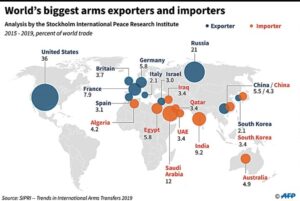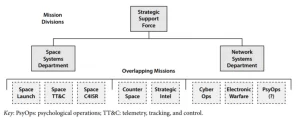
Stockholm International Peace Research Institute (SIPRI) based in Stockholm, is an independent international institute dedicated to research into conflict, armaments, arms control and disarmament. Established in 1966, SIPRI provides data, analysis and recommendations, based on open sources, to policymakers, researchers, media and the interested public.
Recently it published its annual research report on Trends in International Arms Transfer, 2022. The report essentially compares two five years periods i.e. 2013-17 and 2018-22.
Relevant extracts related to trends and concerns are as follows:-
Overview: Exporters
There are 63 states as exporters of major arms. The top 25 arms exporters accounted for 98 per cent of the world’s arms exports in 2018–22.
The five largest exporters of arms during the period 2018–22 are the USA, Russia, France, China and Germany. These five account for over three-quarters (76 per cent) of all arms exports.
States in North America and Europe together accounted for 87 per cent of all arms exports in the period. The five largest exporters in Western Europe (France, Germany, Italy, the United Kingdom and Spain) supplied around one-quarter (24 per cent) of total global arms exports in 2018–22.
USA. US arms exports accounted for 40 per cent of the global total in 2018–22 and were 14 per cent higher than in 2013–17. The USA delivered major arms to 103 states in 2018–22, almost as many as the next two biggest exporters combined. The USA’s arms exports grew by 14 per cent between 2013–17 and 2018–22 and its share of total global arms exports rose from 33 per cent to 40 per cent. Its total arms exports in 2018–22 were 148 per cent higher than those of Russia—the second largest exporter—compared with 50 per cent higher in 2013–17.
Russia. In 2018–22 Russia delivered major arms to 47 states and accounted for 16 per cent of total global arms exports. Russian arms exports remained stable between 2008–12 and 2013–17 but fell by 31 per cent between 2013–17 and 2018–22. The annual volumes of arms exports in 2018 and 2019 were at similar levels to or higher than those in each of the previous 20 years but were at significantly lower levels in 2020, 2021 and 2022.
Others. French arms exports increased by 44 per cent between 2013–17 and 2018–22, while Russian (–31 per cent), Chinese (–23 per cent) and German (–35 per cent) arms exports decreased.
Comments:
- Four major exporters of arms are the USA, European Union, Russia and China.
- Well established defence industry (Eco System) is essential to be a world power.
- Defence export is necessary for the growth of the domestic defence industry.
- While the export trend is upward for the USA, it is downward for Russia and China.
- Are the US-led wars in the world, for the benefit of and encouraged by its arms industry?
Overview: Importers
SIPRI has identified 167 states as importers of major arms in 2018–22. The five largest arms importers in 2018–22, India, Saudi Arabia, Qatar, Australia and China, together received 36 per cent of the world’s arms imports.
The main recipient region in 2018–22 was Asia and Oceania (accounting for 41 per cent of global arms imports), followed by the Middle East (31 per cent), Europe (16 per cent), the Americas (5.8 per cent) and Africa (5.0 per cent).
Six of the world’s 10 largest arms importers in 2018–22 were in Asia and Oceania: India, Australia, China, South Korea, Pakistan and Japan. The USA (31 per cent) accounted for the largest share of arms imports to states in the region, followed by Russia (26 per cent) and France (12 per cent).
Comments:
- Arms are being pumped into Asia and Oceania, making them the biggest hot spots.
- Hot spots in the Middle East are being kept alive to cash in on the prevailing arms market of oil-rich countries.
- After a long period, a hot spot has appeared on the doorstep of Europe.
- China is adding to its military power by every possible means.
Ukraine War
Ukraine imported very few major arms in the period from its independence in 1991 until the end of 2021. This changed after the Russian invasion of Ukraine in February 2022, as the United States and many European states began to send large quantities of military aid to Ukraine. As a result, it became the 3rd largest importer of major arms in 2022, after Qatar and India, and the 14th largest for the five-year period 2018–22, accounting for 2.0 per cent of total global arms imports.
Of the 29 states that supplied major arms to Ukraine in 2022, the main suppliers were the USA, which accounted for 35 per cent of total Ukrainian arms imports during the year, Poland (17 per cent), Germany (11 per cent), the United Kingdom (10 per cent) and Czechia (4.4 per cent).
Ukraine did not receive all the types of arms it asked its supporters to provide and, at different stages, there was a divergence between states about what they were willing to supply. In many cases, the supply of arms by one state was financed by other states or by the European Union (EU) through the European Peace Facility.
Russia, in contrast, relied almost exclusively on domestically produced arms—although it did import unmanned aerial vehicles (UAVs) and flying bombs from Iran in 2022.
Effect: Ukraine War The war in Ukraine had only a limited impact on the total volume of arms transfers in 2018–22, but Ukraine did become a major importer of arms in 2022. In addition, most European states substantially increased their arms import orders and the war will have significant ramifications for future supplier–recipient arms trade relations globally.
Comments:
- USA-led NATO has pushed Russia into the Ukraine conflict, with the benefit of weakening Russia and boost to its arms industry.
- Many of the arms supplied were second-hand items from existing stocks. (Including artillery pieces, guided artillery rockets, old tanks, and anti-tank missiles).
- Some newly produced arms, such as air defence systems were also supplied.
- Most of the arms supplied were vital for Ukraine to halt the Russian offensive and provided limited offensive capability. They essentially boosted the defensive capability, with “urban jungle warfare” and “shoot and scoot” employment philosophy.
- The Suppliers were not prepared to deliver arms with a long-range strike capability, such as combat aircraft and long-range land-attack missiles, presumably because of affordability and more importantly to keep the conflict below a certain threshold.
- The Ukraine conflict will further reduce the Russian arms export in future.
Relevant Aspects: Closer to Home
China. China accounted for 5.2 per cent of total global arms exports in 2018–22. Its arms exports decreased by 23 per cent between 2013–17 and 2018–22. The vast majority of Chinese arms exports (80 per cent) went to states in Asia and Oceania. China delivered major arms to 46 states in 2018–22, but over half of its arms exports (54 per cent) went to just one state—Pakistan.
China’s arms imports grew by 4.1 per cent and accounted for 4.6 per cent of the global total in 2018–22. The vast majority of Chinese arms imports (83 per cent) came from Russia. Russian deliveries in the last three years of the period (2020–22) consisted almost entirely of helicopters and engines for aircraft, which are the last few types of major arms that China has had difficulties in developing.
Comments
- China is increasing its logistic bases in Oceania and IOR, for future expeditionary operations capability.
- China is pumping Chinese arms and equipment into countries of its interest to increase interoperability with them and also make them reliant on China in the long run.
Pakistan. Arms imports by Pakistan increased by 14 per cent between 2013–17 and 2018–22 and accounted for 3.7 per cent of the global total. China supplied over three-quarters (77 per cent) of Pakistan’s arms imports in 2018–22.
Comments
- Pakistan keeps spending money on its military in spite of the economic crisis at home.
- China has boosted Pakistan’s military capability (Army, Navy and Air Force), defence industry, nuclear capability, and long-range missile capability.
India. India’s tensions with Pakistan and China largely drive its demand for arms imports. With an 11 per cent share of total global arms imports, India was the world’s biggest importer of major arms in 2018–22, a position it has held for the period 1993–2022. It retained this position even though its arms imports dropped by 11 per cent between 2013–17 and 2018–22.
Russia was the largest supplier of arms to India in both 2013–17 and 2018–22, but its share of total Indian arms imports fell from 64 per cent to 45 per cent. Russia’s position as India’s main arms supplier is under pressure due to strong competition from other supplier states, increased Indian arms production and, since 2022, the above-mentioned constraints on Russia’s arms exports related to its invasion of Ukraine.
India’s arms imports from France, increased by 489 per cent between 2013–17 and 2018–22. France, therefore, displaced the USA to become the second largest supplier to India in 2018–22.
Comments
- India Continues to retain the dubious record of being the biggest defence importer.
- The import content is showing a downward trend due to the attempts to replace imports with major arms that are designed and produced domestically (self-reliance).
- Russian content in the Indian military is reducing and being replaced by the USA and other Western exporters.
- The Indian military has a very diverse defence inventory resulting in a logistic nightmare. But it is also a blessing in disguise, as far as reliance on one particular supplier is concerned.
- Indian procurement follows the principle of “Maximum bang for the buck”, buying the best available equipment in the market.
Bottom Line
Wheels within wheels in the Arms industry and trade.
Humans are in Self Protect or Self-destruct mode?
Coming Up
Arms TradePart II: Flows vis-à-vis Hot Spots
Suggestions and value additions are most welcome
For regular updates, please register here
Subscribe
References and credits
To all the online sites and channels.
Disclaimer:
Information and data included in the blog are for educational & non-commercial purposes only and have been carefully adapted, excerpted, or edited from sources deemed reliable and accurate. All copyrighted material belongs to respective owners and is provided only for purposes of wider dissemination.


